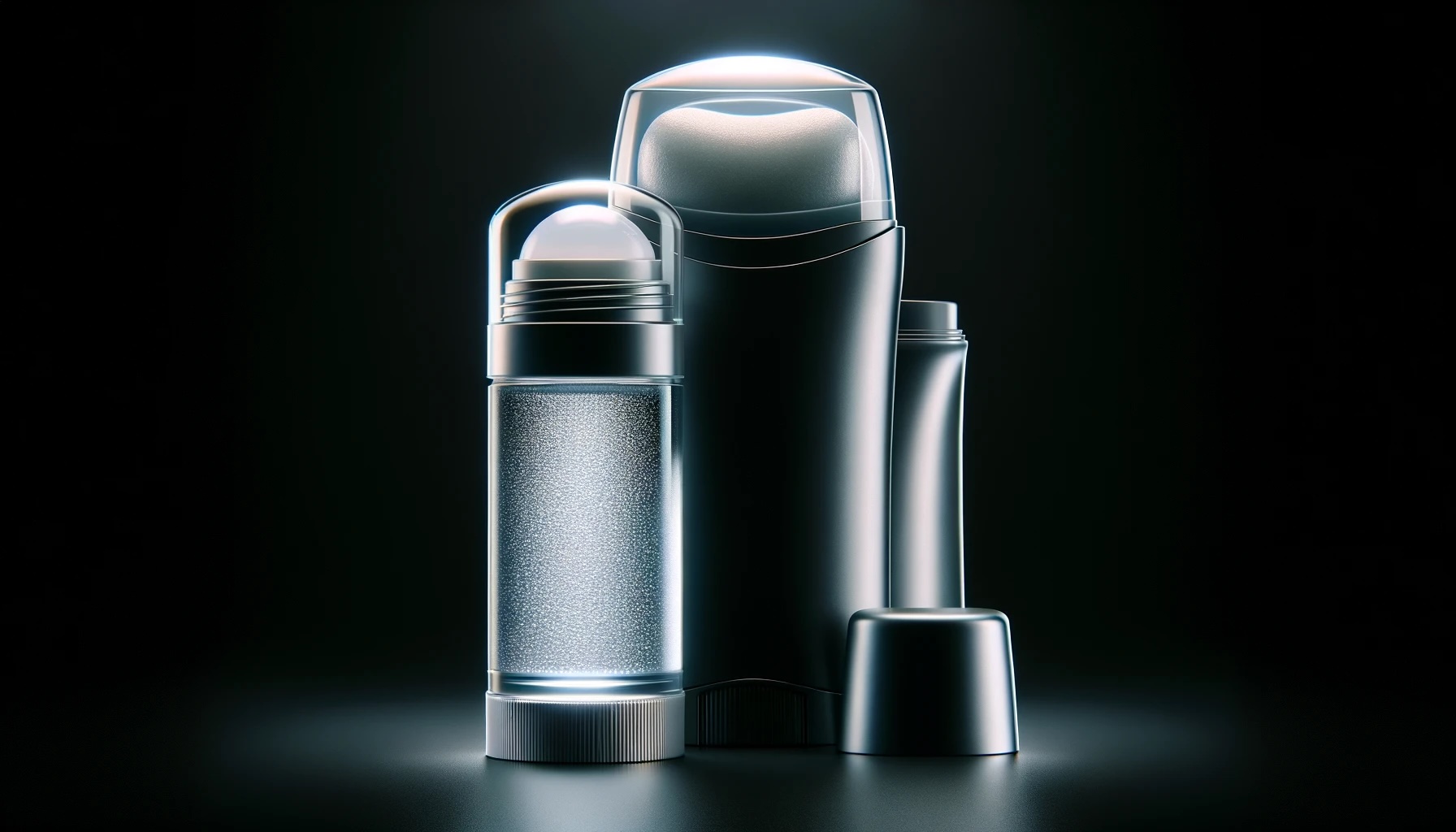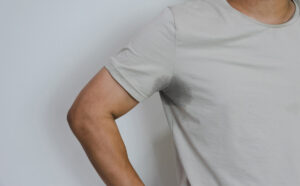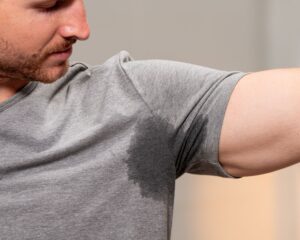Table of Contents
What’s worse than a pair of sweaty armpits?
A pair of yellow sweat stains on your favorite shirt.
There’s no silver lining to sweat stains (more like gold-ish). They’re embarrassing, distracting and ruin your clothes.
If you aren’t careful, they could derail your social life and end up costing you a small fortune. (replacing your favorite outfit every 2 weeks ain’t cheap.)
Here’s the good news, there are ways to prevent sweat stains and ways to get rid of sweat stains after they occur.
We’ll help you with both…
The best way to beat pit stains is to avoid them in the first place.
5 Tips to Prevent Sweat Stains
1. Wear a cheap undershirt to avoid getting sweat stains on your dress shirts and nice clothes. For fitted and tailored shirts you’ll want to use sweat pads or sweat guards.
2. Use a clinical-strength antiperspirant. A strong antiperspirant can prevent bacteria-prone sweat from staining your shirts. Apply antiperspirant before bedtime and let it dry completely before getting dressed. If you put on too much antiperspirant or don’t let it dry completely, it can lead to yellow pit stains.
3. Trim your armpit hair. Your underarm hair can collect excess sweat, dirt, and bacteria (the perfect recipe for sweat stains). By trimming pit hair, you can prevent lingering sweat and odor causing bacteria.
4. Wash sweaty shirts ASAP! The longer you leave a sweaty shirt to dry, the stronger the stain sets in. Handwash sweaty clothes with a little bit of laundry detergent and cold water to keep the stain from setting in.
5. Take it easy with the deodorant. Like some antiperspirants, deodorant can also cause yellow stains on your shirts. To avoid this, apply a light layer to your underarms and let it air dry before dressing. The secret here is to get the deodorant in your pits without getting it on your shirt.
If you can’t stop the sweat stains, these tips will help you to remove them.
How to Get Rid of Pit Stains
Treating sweat stains can be tricky. If you don’t wash your sweat-soiled clothes quickly and properly, the stains can set in — and may not come out at all. But the good news is, it is possible to remove sweat stains from your clothes. In fact, once you know how, it’s actually pretty easy to do.
How to Clean Pit Stains That Aren’t Totally Set In
Do you typically get pit stains on your shirt while you’re working out or while you’re cutting the grass on a hot day? If so, these are the easiest type to remove.
Sweat stains are a lot harder to remove from your clothing once they’ve set in, and for pit stains to set in, they have to dry. So if you can treat your shirt immediately, you won’t have to worry about sweat stains ruining it. And the best part is, all you need to do is run the soiled part of your shirt under some cold water. Then, gently rub the stained part of the fabric together to loosen up the stain and rinse it thoroughly. Once its dry, you can wash it with the rest of your laundry without any worries.
Can Pit Stains Be Removed If They’re Set In?
If you have sweat stains on a shirt that are already set in, they can still be removed. But it will take a bit more work than putting the shirt in cold water. There are several home remedies that will get rid of pit stains, but you need to make sure the one you use works for the type of shirt you have. For example, the process to remove sweat stains from colored clothing is different than the stain removal process you should use on white clothing — which is why we’ve outlined different techniques for you below.
How to Get Rid of Pit Stains on White Shirts
Getting pit stains on white shirts sucks. They are often even more noticeable than sweat stains on colored shirts, so when it happens, it’s can be really embarrassing — especially if you’re on a date or about to go into a big meeting.
But don’t worry. You don’t have to throw out your favorite white T-shirt or nice, crisp dress shirt. Instead, follow these instructions to remove sweat stains from white clothing.
What you need:
- 1 cup of white vinegar
- 1/2 cup of baking soda
- 1 tablespoon of salt
- 1 tablespoon of hydrogen peroxide
- 2 cups of warm water
- A bowl large enough to hold your shirt and the cleaning solution
- Small bowl
- Metal spoon
- Towel
Once you’ve gathered all of your ingredients:
- 1. Pour two cups of warm water and one cup of white vinegar to your bowl.
- 2. Place the shirt in the water and vinegar solution so that the sweat stains are completely covered, and let it soak for between 20 and 30 minutes.
- 3. Combine the hydrogen peroxide, baking soda, and salt together in a small bowl. Then, use the spoon to mix the ingredients together until it forms a paste.
- 4. Cover a flat work surface with the towel.
- 5. Remove the shirt from the large bowl, and then, wring out any excess liquid.
- 6. Spread the shirt out over the towel, use the spoon to spread the paste mixture over the soiled parts of the shirt. Let the mixture sit on the shirt for about 20 minutes.
- 7. Once the paste is set in, wash the shirt with a load of whites as you normally would.
How to Get Pit Stains Out of Colored Shirts
You might be surprised to discover that the same process you use to get sweat stains out of white clothing can’t use on colored clothing — the hydrogen peroxide can ruin them.
To remove sweat stains from colored clothing, soak the item in a mixture of cold water and white vinegar for between 20 and 30 minutes. Then, run cold water over the soiled area, and gently rub the area with your fingers to loosen the stain. Then, wash the clothing like you normally would — in a load with like colors.
If you don’t have white vinegar on hand, crush a few aspirins up. Then, mix the crushed aspirin with water to make a paste. Apply the paste to the soiled area, and let it sit for about an hour before washing the piece of clothing in the washer and dryer.
Why Do Pit Stains Become Yellow?
It isn’t your sweat that causes pit stains to turn yellow. In fact, sweat is actually colorless. (Well, most of the time. There is a condition called chromhidrosis that causes people to have yellow, blue, or green sweat. But for most people sweat doesn’t have a color.)
When your sweat mixes with the bacteria on your skin, your deodorant, your antiperspirant, and even your clothing, it can cause yellow stains to appear on your clothes. But it’s the mixture of the sweat, bacteria, and chemicals that cause the yellow hue — not the sweat alone.
How to Get Rid of Yellow Pit Stains
Yellow underarm stains are probably the most embarrassing, and getting rid of them isn’t easy either. But it can be done.
What you need:
- Liquid dish soap
- Baking soda
- Cold water
- Toothbrush
- Hydrogen peroxide
- Small mixing bowl
When you have your ingredients ready, lay your shirt on a flat surface — inside out. Then…
- 1. In a small bowl combine equal parts of liquid dish soap, baking soda, and hydrogen peroxide — about a tablespoon of each should do the trick. (If you’re working with a colored shirt, replace the hydrogen peroxide with cold water.)
- 2. Spread the mixture on the stained area of the shirt.
- 3. Use the toothbrush to work the mixture into the stain. It will loosen the stain up a bit so the ingredients can work their magic.
- 4. Let the mixture sit on your shirt for about an hour. Then, use your washer and dryer to clean the shirt as you normally would.
If you have yellow pit stains that are really hard to get out, use an old toothbrush to scrub regular table salt into the stain to loosen it up even more.
1. Develop Good Grooming Habits
Guys, this should go without saying, but we need to shower. Every day. Maybe multiple times a day, depending on the ambient temperature and your activity level.
The reality is that when sweat sits on your skin for an extended period of time and has a chance to mix up with the bacteria living on your skin’s surface, you’re in for a pretty nasty time.
Shower Regularly
Showering regularly and washing your man parts can go a long way toward minimizing the embarrassing odor that often accompanies sweaty balls.
Keep in mind that bacteria thrive in a warm, moist environment, so the longer you let your testicles wallow in sweat, the more bacteria have a chance to develop and grow.
A morning shower goes a long way toward resetting the bacteria button every day, but simply rinsing your sweaty balls with water isn’t good enough.
Use Gentle Products Designed For You Private Parts
If you are looking for how to prevent sweaty balls, search for products specifically designed for your private parts that can kill bacteria, moisturize, and knock out odors.
You can even find products that can help soften body hair in the groin area, which helps prevent chafing (your balls will be delighted).
At the very least, use regular soap down there. Both bar soap and liquid versions will get the job done. But try to use unscented, gentle products, and make sure you rinse well.
The skin folds of the scrotum can trap fragrances and chemicals from shower products, which can lead to irritation later in the day.
If you switch over to cool water at the very end of your shower, you can help cut down on the chance of after-shower sweating.
Become Friends With Your Hairdryer
When toweling off, dry your groin carefully. Some experts even recommend blowing air on your testicles using a hair dryer in a cool setting. This can help remove any moisture you missed while toweling off.
If you don’t want to use a hairdryer and have time, you can also simply wait a few minutes before getting dressed to allow your pubic area time to air-dry completely.
Can You Bleach Pit Stains?
While it might seem like bleach would be the best option for removing pit stains from white clothing, it isn’t. In fact, it can actually make the stain worse. So you should avoid using bleach to remove sweat stains from your clothing.
If you prefer not to use a homemade solution, Oxiclean and Puracy Natural Stain Remover are both good alternatives and can work wonders on yellow underarm stains.
Can Dry Cleaners Remove Pit Stains?
So you might be wondering what you should do if you happen to get pit stains on a shirt that’s specifically marked “Dry Clean Only.” In that case, it’s probably not a good idea to try to remove the pit stains on your own.
Professional dry cleaners are able to remove sweat stains from your shirts, but the stains aren’t removed using the normal dry cleaning process. Because of this, it’s important to point the stains out to the cleaner when you drop off your garments. This way, the technician knows that your shirts need to be pre-treated to remove the stains before they are dry cleaned.
Also, because sweat stains are harder to remove the longer they are left to set in, it’s a good idea to take your shirts to the cleaners frequently. It’s actually a good idea to take the shirt to the cleaners the same day if possible.
If you can’t get to the dry cleaner right away, apply a small amount of lemon juice and cold water to the sweat stains on your shirt. This should help prevent the sweat stains from really setting in. Make sure you only use a tiny amount though. It’s okay for the underarm area of the shirt to be slightly damp, but you don’t want to saturate it.
How to Remove Pit Stains From Shirts Before They Set In
Excessive sweating is a lot more common than you probably think. Unfortunately, it’s something that a lot of people have to deal with on a regular basis — and no one wants to walk into a client meeting or complete a presentation with pit stains on their shirt. It’s embarrassing.
If you know you have an important event or you frequently sweat through your work shirts, keep a spare in your office. As soon as you notice sweat stains appearing, change your shirt. Then, take the soiled shirt into the bathroom and run the stained area under cold water. This keeps the stain from setting in completely. You can then hang your shirt in your office to dry. Because the sweat stains didn’t have time to set in, you don’t have to worry about using special cleaning techniques on the shirt later.
If you don’t have a private office, you can still use this technique. Simply keep your spare shirt in your desk drawer or in your car so you have it when needed.
Do Pit Stains Come Out of Silk Shirts?
Pit stains do come out of silk shirts, but we don’t recommend you try to remove the stain yourself. Most silk shirts should only be dry cleaned because the fabric is so delicate. Because of this, you should leave the sweat stain removal to the pros.
Instead of trying to remove sweat stains from a silk shirt yourself, take the shirt to the dry cleaner as soon as possible. As we mentioned above, be sure to point out the stains when you drop off the shirt so it gets the little extra care it needs.
How to Prevent Sweat Stains
Most of the time, it’s a lot easier to prevent sweat stains than it is to remove them. So if you’re prone to excessive sweating, you should consider going on the defensive. But before you learn how to prevent pit stains, you need to understand what actually causes them.
How Do Pit Stains Happen?
According to Mike Thomas of Proctor & Gamble, antiperspirants are actually one of the biggest causes of armpit stains. See, antiperspirant gets absorbed into your clothing, and when it mixes with your sweat, you get nasty yellow pit stains.
But antiperspirants are also the one thing that can help reduce the amount of sweat you produce. Yep, that’s right, we’re back to the Catch-22. If you avoid using antiperspirant, you’re going to sweat a lot more, but using it leaves you with pit stains. So what do you do?
Well, you’re not going to stop using antiperspirant — or deodorant for that matter. Instead, you’re going to change the way you use it.
An Ounce of Prevention
The first thing you need to do when you’re trying to prevent pit stains is to alter your normal routine a bit. The idea is to get your sweating under control first. So instead of applying deodorant and antiperspirant in the morning before you put on your clothing, you’re going to do it at night.
Before you go to bed, take your shower and make sure your underarm area is fully dry. Then, apply a light layer of antiperspirant. We recommend using our SweatBlock towelettes because the clinical-strength antiperspirant actually works to reduce the amount of sweat your body produces for between four and seven days. After wiping your underarm area with the towelette, allow it to dry completely before putting on your pajamas. Then, all you need to do is go to bed and let SweatBlock do the work.
See, the sweat glands in your armpits aren’t as active when you’re sleeping. So it’s a lot easier for antiperspirant to get down into your pores and start working. When you get up in the morning, swipe a thin layer of deodorant onto your armpits — remember, you only want to use a thin layer because sweat stains are caused by the mixture of your deodorant, antiperspirant, and sweat. Now, the most important part is, don’t put your shirt on until your deodorant is fully dry. The key to preventing pit stains is keeping the area as moisture free as possible.
If you need a bit of added protection through the day, carry a travel-size bottle of baby powder with you. It’s easy to apply it to your underarms in small amounts, and it will absorb any moisture in the area right away. Also, don’t forget your undershirt and/or sweat guards. They will help prevent any random sweat stains from soiling your nice clothes. If you prefer an undershirt instead of sweat guards, Thompson Tee undershirts are a good option because they are form fitting, durable, and have a sweat-proof layer of fabric added to the underarm area.
How to Stop Pit Stains Caused By Nervous Sweating
Neverous sweating sucks. We’ve all been there.
It’s totally natural for your body to produce a bit more sweat when you’re nervous, but that doesn’t mean you should have to deal with sweat stains on your shirt too.
There are several things you can do to help prevent nervous and anxiety sweating, which in turn, helps stop the pit stains.
1. Use a strong antiperspirant like SweatBlock to keep your armpits dry. Applying some SweatBlock the night before a high stakes job interview can help reduce that nervous sweat and boost your confidence.
2. Skip your morning coffee or cut down on your daily caffeine intake. Caffeine activates your “fight or flight” mode which leads to higher body temperatures, higher blood pressure, and increased sweating.
3. Meditate. If you can keep calm, you can prevent a lot of the nervous sweating that occurs. How can you do this? Practice some meditation techniques to help calm your nerves. Visualize potentially stressful situations and rehearse them in your mind beforehand. Dissect them, figure out why they trigger anxious feelings or fear. Envision the desired outcome and how it can happen. Simply put, you need to convince your mind that saying “hello”, shaking hands, first dates, public speaking, job interviews and other social interactions are not life-threatening. It’s sounds silly, but it can work. If you can keep your body from switching into this survival mode, you can avoid a lot of the anxious sweat.
4. Manage your diet. Cut down on red meats, processed foods, fast foods and carb loaded treats. These foods make your body work harder to process and lead to increased sweating. You should also avoid spicy foods. Spicy food contains a chemical that tricks your body into thinking temperatures are high. As a result, you sweat more after eating spicy snacks. Drink lots of water, eat vegetables, fruits, calcium rich foods and get your vitamins D and B. These foods can help reduce your body temperature and aid in digestion. All of which promote less sweating.
How to Prevent Pit Stains on White Shirts
Unfortunately, pit stains show up a lot easier on white shirts than they do colored ones. So the easiest way to prevent pit stains from appearing on white shirts is to wear an undershirt or sweat guards to keep the sweat at bay. Sweat guards are also commonly known as garment or dress shields. Some attach to your clothing, while others slide over your arm, attaching to the top of your arm using an elastic band.
You can even make your own garment pads by cutting a panty liner in half. Then, attaching the side with the adhesive to the armpit area of your shirt. This way they absorbent pad soaks up any armpit sweat you have throughout the day.
How to Hide Pit Stains
If all else fails, dressing strategically to hide your pit stains is a great option.
Try following some of these tips to hide embarrassing sweat stains.
Choose your shirt color wisely. Gray, bright, and light-colored shirts aren’t very forgiving, but black and navy shirts hide sweat stains well.
Layer bright colors over neutrals. If you’re worried about sweat stains, bright colored shirts are the worst option. So instead of choosing a bright colored shirt, opt for a neutral brown, navy, or black shirt and wear a bright jacket over it.
Wear cotton or linen shirts instead of shirts made of polyester or rayon. Synthetic fabrics don’t let your skin breathe at all. If possible, consider choosing a shirt made with moisture-wicking fabric.
Choose loose-fitting clothing. Shirts that are cut with long, flowing sleeves let air flow freely, which keeps your shirt away from your skin as much as possible.
In the end, a good strategy for preventing sweat stains is the best way to get rid of them: Stay clean, stay hydrated, eat healthy, dress strategically, manage stress, and use a strong antiperspirant like SweatBlock (be sure to apply at night and let it dry before getting dressed).
You might also like...

Antiperspirant vs Deodorant: What’s the Difference?
Table of Contents Did you know that deodorant and antiperspirant aren’t the same? It’s okay if you didn’t; most people

8 Best Sweat Proof Shirts for Men and Women
Table of Contents It’s almost summer, and you know what that means. Vacations, cool drinks, lying on the beach, you

Top 10 Best Deodorants For Sweaty Armpits
Do you struggle with sweaty armpits? Has your deodorant let you down when it comes to stopping sweat and providing
















